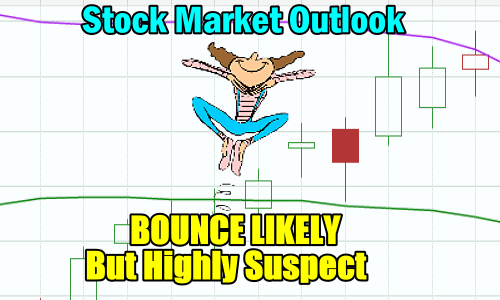
Friday saw an enormous plunge at the open that took out three more support levels in the S&P. However the day also saw wide swings with the index closing the day back at the highs for the day.
Looking at the intraday chart for Friday Feb 28, you can see the wide swings from the morning lows at 10:00 AM through to two attempts to reach the 2960 support level. There are three support levels which the index hit on Friday, 2960, 2900 and 2860. 2900 is good support but better support for the rally is back at 3000. At some point in the upcoming week, we should see the S&P retake 3000. Whether it can hold 3000 will depend on investor sentiment and fear level. Friday for now though looks like a washout day, but the entire plunge has been based on emotions which, once investors calm down, often stabilizes and then recovers some of the lost valuations.
My weekend was spent answering dozens of emails from worried investors. This shows the high emotions presently in the markets. Aside from early 2009 (not 2008), I have not received this many emails and investors worry that this could end up being as bad or worse than the financial crisis where the markets lost half of their values from the highs of 2006-2007. I am not expecting that will be the case. The sars scare of 2003 wiped out 15% from the S&P over a course of 3 months before a recovery in the markets set in. Some investors could argue that the sars scare extended the market collapse of 2002 to 2003 by several months. That could indeed be the case as the S&P was recovering in December of 2002 and then fell back and retested the lows of July and October 2002 before finally beginning another rally ending the bear market which started in September 2000.
For the present scare, the S&P was pushing to new all-time highs when the market imploded last week leaving the S&P down 12.9% from its all-time high by the close on Friday. The market drop in late 2018 was 20%, with the decline in December 2018 being 16% on its own. Based on past corrections it is probable that investors should expect more downside still ahead but that does not mean there won’t be rallies and possibly strong ones. It does mean however that investors can take their time and be selective entering trades on further downside moves. In other words, there is probably no rush to getting into trades unless it is for a day trade in a bounce.

Stock Market Outlook Chart Comments At The Close on Fri Feb 28 2020
The SPX chart is very bearish following seven straight days of selling. The 21 day moving average is ready to fall below the 50 day which will be a major sell signal. The 50 day moving average is already turning down. The 100 day is no longer climbing and starting to turn lower.
The index broke through 3000 before markets even opened and started the day well below the 200 day moving average.
The next level of support is at 2960, just a few points above where the S&P ended the day on Friday. The market is extremely oversold and the closing candlestick on Friday points to a probably bounce for Monday, but it has pointed to a bounce for 3 trading days without any meaningful bounce occurring.

Stock Market Outlook review of Feb 28 2020
Stock Market Outlook: Technical Indicators Review:
Momentum: Momentum is falling for a ninth day and is at extreme oversold levels.
- Settings: For momentum I use a 10 period when studying market direction.
MACD Histogram: MACD (Moving Averages Convergence / Divergence) issued a down signal on Friday Feb 21. The down signal was extremely strong again on Friday and very oversold. The down signal is at readings normally seen in bear market panics. A bounce should be anticipated.
- Settings: For MACD Histogram, I am using the Fast Points set at 13, Slow Points at 26 and Smoothing at 9.
Ultimate Oscillator: The Ultimate Oscillator signal is rising and signaling a bounce from oversold is expected.
- Settings: The Ultimate Oscillator settings are: Period 1 is 5, Period 2 is 10, Period 3 is 15, Factor 1 is 4, Factor 2 is 2 and Factor 3 is 1. These are not the default settings but are the settings I use with the S&P 500 chart set for 1 to 3 months.
Slow Stochastic: The Slow Stochastic has an up signal in place for Monday and is very oversold. The signal here is at levels seen usually in bear market panics.
- Settings: For the Slow Stochastic I use the K period of 14 and D period of 3. The Slow Stochastic tries to predict the market direction further out than just one day.
Relative Strength Index: The RSI signal is still falling and now into levels seen during extreme sell-offs which are followed by bounces.
- Settings: The relative strength index is set for a period of 5 which gives it 5 days of market movement to monitor. It is often the first indicator to show an overbought or oversold signal.
Rate of Change: The rate of change signal is extremely oversold and at levels where bounces usually are imminent.
- Settings: Rate Of Change is set for a 21 period. This indicator looks back 21 days and compares price action from the past to the present. With the Rate Of Change, prices are rising when signals are positive. Conversely, prices are falling when signals are negative. As an advance rises the Rate Of Change signal should also rise higher, otherwise the rally is suspect. A decline should see the Rate Of Change fall into negative signals. The more negative the signals the stronger the decline.
Support and Resistance Levels To Be Aware Of:
3400 is resistance
3300 is resistance
3200 is light resistance
3100 is light resistance
3075 is light resistance
3000 was good support and may be revisited next week
2960 is light support
2900 is light support
2860 is light support
2840 is good support
2800 is strong support
Stock Market Outlook for Tomorrow – Mon Mar 2 2020
Fear was rampant on Friday. The VIX Index brushed almost the 50 reading, jumping to 49.48. This is a level last seen in March 2018 when the reading reached 50.30 and in March 2009 when readings of over 50 were common in the financial crisis.
The market attempted to bounce on Friday from its lows and managed to almost recover the 2960 support level. However the plunges each day during the week wiped out numerous technical support levels purely through emotional selling. It wasn’t just novice investors panicking. Professional investors, hedge fund managers and pension funds were selling out as each day volumes were huge. The chance this will end with a V shaped recovery this week are slim.
Monday should see another bounce attempt with technical indicators pointing to an extremely oversold market and all signals point to an imminent bounce. I believe any bounce will be sold into by nervous investors still trying to reduce their exposure to equities. So while a bounce is probable for Monday, it remains highly suspect that it will not mark the end of the sell-off, just a lull.
Stock Market Outlook Archives
Morning Investing Strategy Notes for Wed Jan 8 2025

Stock Market Outlook for Wed Jan 8 2025 – Possible Rally Attempt But Still Lower

Morning Investing Strategy Notes for Tue Jan 7 2025

Stock Market Outlook for Tue Jan 7 2025 – Morning Bounce Likely But Lower Close

Morning Investing Strategy Notes for Mon Jan 6 2025

Stock Market Outlook for Mon Jan 6 2025 – Morning Dip Likely But Higher Close

Morning Investing Strategy Notes for Fri Jan 3 2025

Stock Market Outlook for Fri Jan 3 2025 – Second Bounce Attempt Expected

Morning Investing Strategy Notes for Thu Jan 2 2025

Stock Market Outlook for Thu Jan 2 2025 – Bounce Likely But Bye Bye Santa

Morning Investing Strategy Notes for Tue Dec 31 2024

Stock Market Outlook for Tue Dec 31 2024 – Possible Bounce But Santa May Be Gone

Morning Investing Strategy Notes for Mon Dec 30 2024

Stock Market Outlook for Mon Dec 30 2024 – Looking For Santa Claus Rally

Morning Investing Strategy Notes for Fri Dec 27 2024

Stock Market Outlook for Fri Dec 27 2024 – Still Bullish

Morning Investing Strategy Notes for Thu Dec 26 2024

Stock Market Outlook for Thu Dec 26 2024 – Continuing To Run Higher

Morning Investing Strategy Notes for Tue Dec 24 2024

Stock Market Outlook for Tue Dec 24 2024 – Weakness With Possible Dip But Still Bias Up

